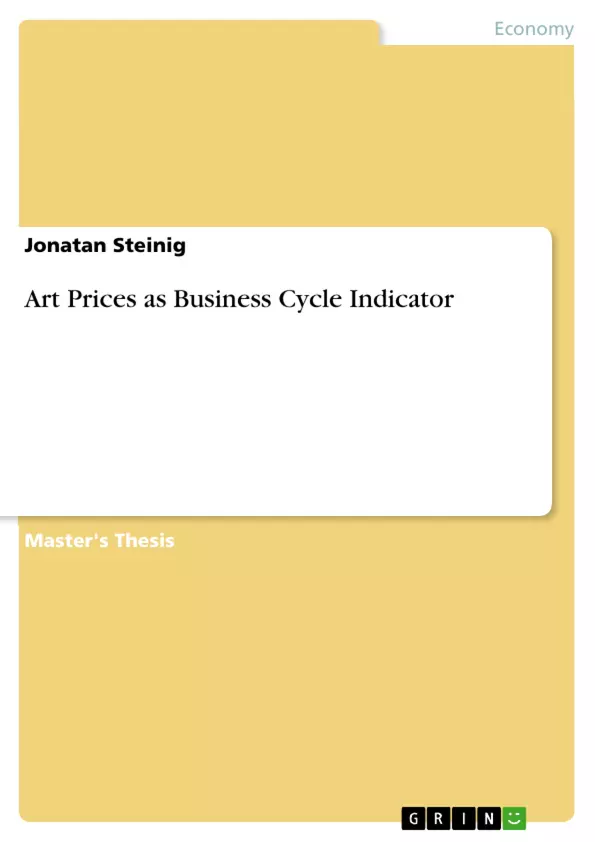“When bankers get together for dinner, they discuss Art. When artists get together for dinner they discuss money.” (Oscar Wilde)
Works of art are unique and highly heterogeneous but if they are traded, they share the common purpose of creating income. However, not only artists will discuss money at dinner, also bankers while they discuss art, are likely to talk about financial gains through investments in art. In economics a small group of researchers has examined whether this kind of investment is profitable or not. Although findings are not consistent, some authors conclude that art, compared to equity or bonds, does perform relatively well and offers diversification benefits in investment portfolios. Despite the inconsistency of findings, this research has led to a growing interest in art investment. Promoters of art investment like art investment funds work on a transformation of art into a new and widely accepted asset class, which they hope will prospectively be included in investment portfolios in the same way as real estate (Picinati di Torcello (2012): 15).
Investment in art is determined by the expected price appreciation of art works in the future (Stein (1977): 1021). The quantity of original artworks, at least by deceased artists, cannot be augmented and the elasticity of supply is zero (Baumol (1986): 10). The future prices of art works as investment goods will thus depend on demand as well as on wealth of individuals and institutions at the sales date (Goetzmann (1993): 1371). The greater the purchasing power of prospective buyers, the more art is being bought and the higher art prices will be (Goetzmann et al. (2009): 2). Consequently art prices are expected to react to changes in economic prosperity and to fluctuate in the course of the business cycle.
Business cycle research is a vital branch of macroeconomics and many theories and studies exist which examine the boom and bust periods of the economy as different phases of business cycles. Contrary there is little research which looks at “the link between the art market and the broader economy” (ibid: 4).This master thesis aims at contributing insights on this link by analysing the behavior of art prices under different macroeconomic conditions. Precisely, the objective is to assess the characteristics of art prices as business cycle indicator for the U.S. economy. [...]
Inhaltsverzeichnis (Table of Contents)
- 1. Introduction
- 2. Theoretical background
- 2.1 Art as an investment object
- 2.1.1 Integration of art as an asset into investment portfolios
- 2.1.2 Art market composition and key players in the global art trade
- 2.2 Primary features of business cycle
- 2.2.1 Moving from a stationary to a booming economy
- 2.2.2 Looming recession and financial crises
- 2.3 Can prices at art auctions be used to predict shifts in the business cycle?
- 2.3.1 Classical versus growth cycle analysis
- 2.3.2 Art prices as business cycle indicator: direction and timing
- 2.1 Art as an investment object
- 3. Methodology
- 3.1 Data and summary statistics
- 3.2 Analysis of stationarity and data filtering
- 3.2.1 Stationarity - Augmented Dickey Fuller (ADF) test
- 3.2.2 Applying the Hodrick Prescott filter
- 3.3 Cross-correlation with GDP
- 3.4 Granger Causality and analysis of stability
- 3.4.1 Granger Causality
- 3.4.2 Analysis of stability
Zielsetzung und Themenschwerpunkte (Objectives and Key Themes)
This master thesis investigates the potential of art prices at auctions as a predictor of shifts in the business cycle. The study aims to explore the theoretical foundation for using art as an investment object, analyze the key features of business cycles, and ultimately examine if art prices can reliably indicate upcoming changes in the economic climate.
- Art as an investment asset
- Key features of business cycles
- Art prices as a business cycle indicator
- Data analysis of art market data and GDP
- Granger causality and stability analysis
Zusammenfassung der Kapitel (Chapter Summaries)
Chapter 1 introduces the research question, outlining the potential of art prices as a business cycle indicator. Chapter 2 delves into the theoretical framework, exploring the role of art as an investment asset, outlining the key features of business cycles, and discussing the potential for utilizing art prices to predict economic shifts. Chapter 3 details the methodology employed, including data selection, analysis of stationarity and data filtering, cross-correlation with GDP, and Granger causality analysis.
Schlüsselwörter (Keywords)
The main keywords and focus topics of this work are: art market, art as an investment asset, business cycle analysis, art prices, GDP, Granger causality, stationarity, Hodrick Prescott filter, data analysis.
- Citation du texte
- Jonatan Steinig (Auteur), 2015, Art Prices as Business Cycle Indicator, Munich, GRIN Verlag, https://www.grin.com/document/301197



